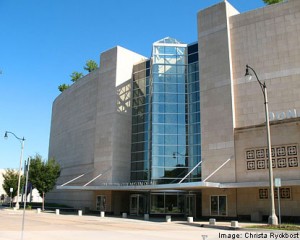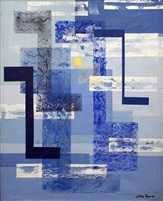Rare Pereira audio interview
November 16, 2009 Comments Off on Rare Pereira audio interview
Women Artists
Women Artists by Margaret Barlow (Rizzoli, 2008, 328 pp) offers an insightful appreciation of Pereira’s career and a color plate of the rarely reproduced What Is Substance?
Ms. Barlow is co-editor of the Woman’s Art Journal. The journal is associated with the Institute for Women and Art at Rutgers.
Pereira wrote extensively about the concept of substance and the Bodleian Library at Oxford University, UK, has twelve volumes of Pereira notes on the subject.
Women’s Arts Journal.
April 14, 2009 Comments Off on Women Artists
Pereira in the Beat and Jazz eras
Jim Burns, the English poet, is a scholar of the Beat and Jazz eras. He is for this reason of interest to Irene Rice Pereira researchers. Pereira lived during her most creative years on Fifteenth Street just west of Sixth Avenue in Chelsea, the neighborhood just north of Greenwich Village where so much of those eras were lived.
(Because an imposing armory blocked her view from the front of her third floor flat, she painted in the rear where she could take advantage of north light).
Burns collects books about those formative times, and, as it turns out, a number of them refer to Pereira’s work. He has generously provided a list of such works in his personal library:
– Advancing American Art: Politics and Cultural Confrontation in Mid-Century by Taylor D. Littleton and Maltby Sykes, University of Alabama Press, 2005.
– Jackson Pollock: A Biography by Deborah Solomon, Cooper Square Press, 2001.
– Clement Greenberg: A Life by Florence Rubenfeld, Scriber, 1997.
– Surrealism in Exile and the Beginnings of the New York School by Martica Sawin, MIT Press, 1995.
– Abstract Expressionist Painting in America by William C. Seitz, Harvard, 1983.
– Most of the references are single ones, Burns says, thought the first book, Advancing American Art, has more details and reproduces her painting, Composition (1945), which was included in the exhibition, Advancing American Art, which was scheduled to tour in 1946-47 but was withdrawn after being attacked by some politicians and right-wing journalists.
Burns’s list prompted a recollection by Djelloul Marbrook, the artist’s nephew. In 1963, he recalled, Pereira took part in picketing the Museum of Modern Art with other artists and writers. One of their complaints was that the museum had senabled Abstract Expressionism to steamroller other developments in American art.
Pereira was particularly articulate and passionate on this score, telling the BBC, which covered the event, that Abstract Expressionism had introduced a European angst to an exuberant American art scene. This remark was to prove problematical for her career, because it was misinterpreted in some quarters as an anti-Semitic sentiment, since many of the Abstract Expressionist painters were Jewish and had immigrated from Europe. Marbrook says this accusation stunned Pereira. She had meant simply that a more optimistic vein in American art had been shortchanged by the attention then being given Abstract Expressionism. The incident earned her important enemies.
Pereira participated in the life of Greenwich Village in the 1930s, 40s and 50s. Marbrook remembers her sending him with some money for the hard-luck poet Maxwell Bodenheim. Pereira herself experienced hard times, but her first inclination upon selling a painting and after paying her rent was to share some of her money with a fellow artist or poet.
The title on Surrealism struck another chord in Marbrook’s mind. His mother, the artist Juanita Guccione, Pereira’s younger sister, had been involved with the Surrealists in exile in New York City. She had done art work for their newspaper, Pour La Victoire. Both women studied with Hans Hofmann in Manhattan and Provincetown, MA.
Burns is the author of As Good a Reason As Any, Redbeck Press, UK, 1999;
Confessions of an Old Believer, Redbeck Press, 1996; Cool Kerouac, Limited and numbered edition, The Beat Scene Press, UK, 2008; What I Said, Eyelet Books, UK, 2008; and other books of poems, essays and stories.
September 2, 2008 Comments Off on Pereira in the Beat and Jazz eras
A rare gem in Utica, NY
Vacillating Progression, a Pereira oil on layers of coruscated glass is one of the artist’s best works. Displayed at The Munson Williams Proctor Arts Institute in Utica, New York,it ranks with such other Pereira masterworks as Green Mass at The National Gallery of Art, Washington, DC. There is hardly a better exemplar of the artist’s reputation than this singular work. – DM
July 27, 2008 Comments Off on A rare gem in Utica, NY
Pereira in Baruch College gift
Among a small group of art works donated by Sidney Mishkin to his alma mater, Baruch College, is Irene Rice Pereira’s Affluent Surface. Other paintings in this highly refined selection are Max Ernst’s Mother and Daughter, Barbara Hepworth’s Bimorphic, Marsden Hartley’s Mount Katahdin Snowstorm, Alfred Henry Maurer’s Two Women and Girl in Grey, Georges Mathieu’s Festival in Norwich, and untitled works by
Alexander Calder and Roberto Sebastian Antonio Matta Echauren.
Djelloul Marbrook, Pereira’s nephew, said of the gift that it would have pleased Pereira on several counts, not the least being that she spent a good part of her life painting in a studio an easy walk from Baruch’s present location. He remarked that Pereira thought highly of Ernst, Hartley, Hepworth, Matta and Calder.
April 13, 2008 Comments Off on Pereira in Baruch College gift
Light Extending Itself
A 1964 Pereira oil painting, Light Extending Itself, is part of the Non-Objective Art exhibition at The Brooklyn Museum. This exhibition is itself part of the larger Modern Life exhibition on the 5th floor. Light Extending Itself is the gift of Howard Weingrow.
Pereira had a special connection to Brooklyn. She, her two sisters, brother and mother lived near the museum when Pereira first went to work as secretary to help support the family. She and her younger sister, the artist Juanita Guccione, then called Anita Rice, followed their younger sister, Dorothy, into art studies, but Dorothy died in her early thirties.
Both Irene and Anita studied at Pratt Institute and traveled to North Africa in the 1930s. Irene visited various places in Morocco and Algeria. Anita settled in Bou Saada, Algeria, for several years. Their experience of
the quality of light in North Africa had a lasting impact on their work.
In 1935-6, Anita, who then painted under the name Juanita Marbrook, exhibited a number of paintings she had made in Algeria in The Brooklyn Museum. The work received considerable media attention at the time. These works are now part of 174 oils, watercolors and drawings permanently exhibited in Algiers by Sonatrach, the Algerian national energy company. It is believed the artist is the first American woman painter to receive this kind of attention by a Muslim nation.
April 12, 2008 Comments Off on Light Extending Itself
New Schlesinger documents
The Pereira archive at the Schlesinger Library, Radcliffe Institute, Harvard University, is receiving a significant addition of documents and photographs.
Djelloul Marbrook, the artist’s nephew, recently discovered two boxes of papers and photographs overlooked in his initial donation of the Pereira papers to the Schlesinger.
The original papers were given to the Schlesinger after the artist’s death in 1971 and subsequently Mr. Herrick Jackson made a grant to the library to pay for organizing the archive. The library is located in Cambridge, Massachusetts.
Ms. Kathryn Allamong Jacob, Schlesinger curator of manuscripts, said, (We are excited at the prospect of seeing this wonderful collection grow.)
The artist’s personal library resides at the National Museum for Women in the Arts in Washington, DC.
This is the Schlesinger Library’s official description of its Pereira holdings:
Author : Pereira, I. Rice (Irene Rice), 1902-1971
Title : Papers, 1929-1976 (inclusive)
Finding aids : Unpublished finding aid.
Description : 10 linear ft.
History notes : Abstract painter, poet, and philosopher, Pereira was a major figure in the art world from 1930. She worked with the WPA Federal Art Project in New York, 1935-1939; in the 1940s she experimented with new media (glass, plexiglass, and plastic) of the constructivist school; and in the 1950s she returned to paint and canvas. She published numerous books on aesthetics and the philosophy of art. For further biographical information, see Notable American Women: The Modern Period (1980).
Summary : Correspondence, manuscripts of her writings, notebooks on philosophy, articles, poems, painting inventories, photos, both personal and of art work, exhibition catalogs, financial records, grant applications, and printed material pertain to Pereira’s interests and career.
Restrictions : At least one location has information and/or restrictions on access. Click on the holdings link(s) for specific information.
Notes : Portions of the collection are available on microfilm at the Archives of American Art.
Cite as : I. Rice Pereira Papers. Schlesinger Library, Radcliffe Institute, Harvard university.
January 10, 2007 1 Comment
Oklahoma City Museum of Art
 Pereira’s “Study for a Rug” was exhibited May 11-August 19, 2007, at the new Donald W. Reynolds Visual Arts Center in the Oklahoma City Museum of Art as part of the exhibition, “Breaking the Mold: Selections from the Washington Gallery of Modern Art, 1961-1968.” The Oklahoma City Museum bought the entire WGMA collection of 153 works in 1968 when the WGMA merged with the Corcoran Gallery of Art in Washington.
Pereira’s “Study for a Rug” was exhibited May 11-August 19, 2007, at the new Donald W. Reynolds Visual Arts Center in the Oklahoma City Museum of Art as part of the exhibition, “Breaking the Mold: Selections from the Washington Gallery of Modern Art, 1961-1968.” The Oklahoma City Museum bought the entire WGMA collection of 153 works in 1968 when the WGMA merged with the Corcoran Gallery of Art in Washington.
September 27, 2006 Comments Off on Oklahoma City Museum of Art
“Spirit of Space” in Exhibition
 Irene Rice Pereira’s Spirit of Space (1957) was included in the exhibition “femme brut(e)” September 14, 2006, through February 4, 2007, at the Lyman Allyn Art Museum, 625 Williams Street, New London, CT, tel (860) 443-2545 (http://www.lymanallyn.org/exhibitions.html)
Irene Rice Pereira’s Spirit of Space (1957) was included in the exhibition “femme brut(e)” September 14, 2006, through February 4, 2007, at the Lyman Allyn Art Museum, 625 Williams Street, New London, CT, tel (860) 443-2545 (http://www.lymanallyn.org/exhibitions.html)
September 9, 2006 3 Comments
